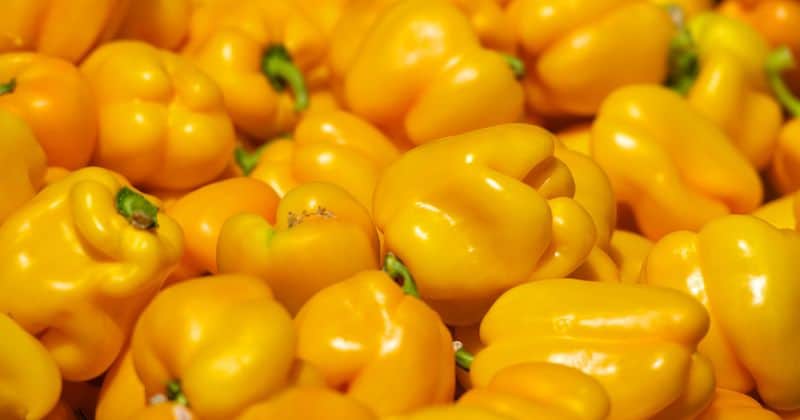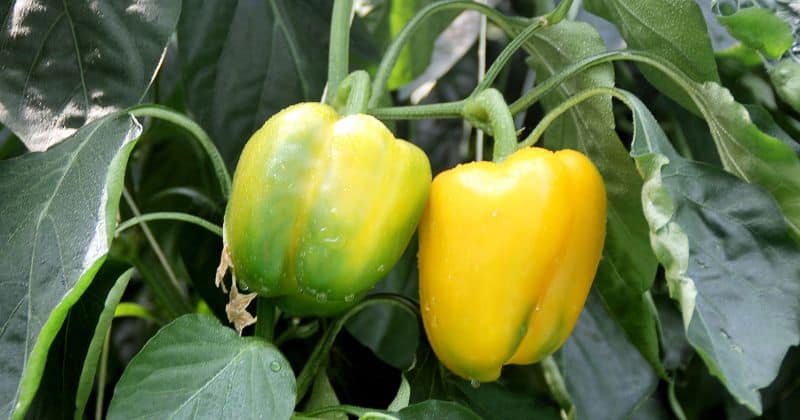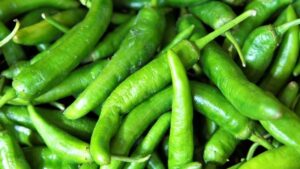If you love growing bell peppers, you may be wondering: when should I harvest my yellow bell peppers? Knowing the ideal time to pick ensures you get the sweetest, juiciest peppers.
Well, you’ve come to the right place! In this article, we’ll explore:
- The signs yellow bells are ripe and ready to pick
- Exactly when to start harvesting yellow peppers
- Pro tips for picking peppers without damage
- How to store your yellow bell bounty
Growing vibrant, delicious yellow bells is totally rewarding. With this guide, you’ll become a pro at picking peppers at their flavorful best.
So let’s dive in and discuss how to harvest the ultimate yellow bells!
First Things First – Why Grow Yellow Bells?

Yellow bell peppers are downright delightful. When ripe, they turn a bright, sunny yellow that looks gorgeous on the plant or diced up in a salad.
Here’s a quick run-down of why yellow bells should be on your must-grow list:
- Sweet flavor – Yellow peppers are one of the sweetest, with a mild, fruity taste perfect for eating raw. Red bells can sometimes have a bitter kick.
- Vitamin C boost – A yellow bell packs over 200% of your daily vitamin C. That’s more than even an orange!
- Eye-catching color – The vibrant yellow hue will make your garden or dishes pop.
- Picking flexibility – Yellow peppers mature earlier than other colors, so you can harvest sooner.
Got your mouth watering for those sweet, juicy yellow peppers yet? Keep reading to find out exactly when and how to pick them!
How to Know When Yellow Bells are Ripe and Ready
Timing is everything when it comes to harvesting peppers. Pick too soon, and you’ll end up with a bland, tough bell. Wait too long and it will be mushy and overripe.
Luckily, there are some clear signs to look for so you’ll know precisely when to start picking your yellow beauties.
Check the Color
This one’s obvious – the first hint your yellow bell is ripe is when it turns completely yellow. Green peppers are unripe fruits that haven’t developed their sugars yet.
Once your green bell transitions to a uniform, vibrant yellow, it’s a sign it’s maturing. But color alone doesn’t tell the whole story…
Feel the Firmness
Mature yellow peppers should feel rigid and solid when you gently squeeze them. If the flesh gives way and feels squishy, it is overripe.
Use the “finger test” – apply gentle pressure and watch for indentations. Ripe yellow bells will be firm with no finger impressions.
Inspect the Skin
A ripe yellow pepper will have smooth, shiny skin free of blemishes or wrinkles.
Wrinkly skin means the pepper is overripe and the inside likely becoming mushy. A yellow bell ready for picking will be flawless.
Check the Shoulders
Mature peppers broaden at the shoulders as they fill out. When the shoulders feel wide and bulgy, your yellow bell is hitting its peak.
Immature peppers have narrow, bony shoulders before widening. Plump shoulders indicate ripeness.
Examine the Stem
When a yellow bell is optimally ripe, the stem will look dried out and shriveled near the attachment point.
If the stem and cap still appear fresh and green, leave the pepper longer for maximum sweetness. A dried stem is ripe for picking!
Give It a Sniff
Finally, use your nose. Take a whiff of the pepper’s stem end. A fully ripe yellow bell will smell sweet and fragrant, almost fruity.
If it lacks aroma or smells grassy, it needs more time. Trust your sniffer to detect when your peppers are perfectly ripe!
When to Pick Yellow Peppers
Now that you know what to look for, when exactly should you start picking? Here’s a timeline so you know when to start checking your plants:
- Days to maturity: 65-75 days from transplanting
- Color break: Begin checking yellow bells once you spot the first signs of color change from green to yellow. This happens around 60 days.
- Time to harvest: Start picking once peppers turn completely yellow, feel firm, and pass the ripe tests. This is around 65-75 days after transplanting.
- Prime season: You’ll get the highest yields and sweetest peppers if you can time the bulk of ripening with the peak of summer.
- First harvest: Pick early-ripening peppers once fully yellow, then let later fruits continue ripening for a prolonged harvest.
- Last harvest: Finish up harvesting any remaining peppers before your first expected autumn frost.
Now let’s talk about how to pick those perfect golden beauties…
Pro Pepper Picking Tips
Harvesting your yellow bells is incredibly rewarding after watching your plants grow all season.
Follow these pro tips for picking peppers so you don’t damage the plant or ruin the fruits:
- Use clean, sharp scissors or secateurs to snip the stem – don’t yank or tug peppers off.
- Try to pick in dry weather to keep picked peppers dry.
- Handle peppers gently to avoid bruising.
- Wear gloves – those bright yellow beauties can dye your hands!
- Pick in the morning when peppers are cool and crisp.
- Use both hands to gently twist and remove any clinging stems.
- Place freshly picked peppers directly into a basket or vented bag.
- Avoid overloading your picking container – don’t crush the goods!
Bonus Tip
Leave a tiny bit of stem attached to each pepper. This helps them keep longer in storage. Now let’s talk about how to enjoy that bounty!
Storing Your Yellow Pepper Bounty
All those sweet, crisp yellow bells won’t last long once picked, so proper storage is key. Here are your best options for keeping your harvest fresh:
Refrigeration
For short-term storage, the fridge is best. Place unwashed peppers in a perforated plastic bag in the high-humidity drawer. They will last 5-7 days.
Freezer
Chop and flash freeze slices or chunks of yellow bell on a baking sheet before transferring to airtight freezer bags. Frozen, they’ll keep 6-8 months.
Canning
Properly canned yellow peppers submerged in brine or water will keep up to a year in sealed, sterilized mason jars.
Pickling
Pickled yellow peppers can be stored 2-3 months once cooled completely and refrigerated in sterilized jars submerged in your brine of choice!
Drying
Dehydrate sliced yellow bells in a food dehydrator or low oven until completely desiccated and brittle. Dried peppers can be stored in an airtight container for up to a year!
Now you’ve got the know-how for growing and harvesting the sweetest, juiciest yellow bells around. Get out there and start picking your peppery bounty!
FAQ:
What’s the lowest temperature yellow bell peppers can tolerate?
Yellow bell pepper plants thrive in warm weather, but dislike cold below 50°F (10°C). Temperatures lower than 45°F (7°C) can damage plants and prevent fruiting. Use row covers or greenhouse structures to protect plants if cold snaps threaten your yellow bell crop.
Will Red Bell Peppers Turn Yellow?
This is a common question for gardeners growing bell peppers. The short answer is – no, red bell peppers will not turn yellow.
Here’s a bit more info:
Bell peppers begin as green fruits. As they ripen, they can turn yellow, orange, red, brown, or purple depending on the variety.
However, once a red bell pepper has achieved its final ripe color, it will not suddenly change to yellow. The internal chemistry and pigments that cause the color change have completed their work.
Two things that can make a red pepper later appear more yellowish:
- Overripening – when a ripe red pepper stays on the plant too long, it fades and shrivels, taking on a paler, orangey-red tone. But this is from age, not any reversal in color.
- Sunscald – intense sun exposure can burn the red pigment of ripe pepper skins, giving them a yellowish cast in spots. But the flesh underneath remains red.
While you may see online claims that red bells “turn yellow” when overripe, this isn’t an actual color change. Mature red peppers won’t spontaneously become yellow. But they may fade as they pass their prime.
So for the brightest red bells, harvest them promptly when fully ripened! The color transition only goes one way – from green to red.





